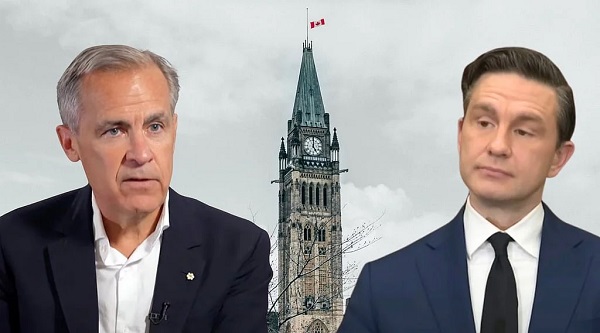Opinion
Premier Scientific Journal Nature Takes on ‘Climate of Fear’ Surrounding Research on Sex and Genr

From Heartland Daily News
“These articles are using phrases like ‘a person’s sex assigned at birth’. I find that phrase amusing. I don’t think sex is assigned at birth. Biological sex is a fact. It’s not assigned. It’s observed.”
Nature, one of the world’s premier scientific journals, has acknowledged the importance of studying sex and gender differences and officially denounced the “climate of fear and reticence” that is stymying research on the topic.
To that end, the journal in May launched “a collection of opinion articles” on the topic to be published over the coming months to foster honest and courageous discussions on a topic that many scientists shy away from due to fears of professional and personal repercussions.
“Some scientists have been warned off studying sex differences by colleagues. Others, who are already working on sex or gender-related topics, are hesitant to publish their views,” read the editorial introducing the series.
“…In time, we hope this collection will help to shape research, and provide a reference point for moderating often-intemperate debates.”
Headlines that kicked off the series include “Neglecting sex and gender in research is a public-health risk,” “Male–female comparisons are powerful in biomedical research” and “Heed lessons from past studies involving transgender people: first, do no harm.”
What the collection of articles represents and whether it will ease tensions surrounding this area of research remains to be seen.
Jeffrey Mogil, a neuroscientist and pain researcher at Mcgill University, as well as the co-author of one of the articles in Nature’s sex and gender series, told The College Fix there is an effort underway in biological research to do away with or minimize the importance of the concept of sex and sex as a binary variable.
This is problematic, Mogil said in a recent telephone interview, because sex in mammals is “either binary or it rounds to binary and in doing so it always has been useful and continues to be and any conception of it that isn’t binary would then impose practical difficulties on how science is done.”
Moreover, he noted, discarding the notion of binary sex in mammals would set back important advancements in how many biomedical researchers now do their work.
“There are sex differences in all kinds of traits that we’re interested in and where we didn’t know they existed,” Mogil said. “The reason we didn’t know they existed [is] because until extremely recently, essentially all biology pre-clinical experiments were done with males only.”
“Since regulatory agencies, funding agencies, have demanded that people start using both sexes [in research],” he said, “lo and behold, we’re finding sex differences.”
“We’re finding that what we thought was the biology of a thing was only the biology of the thing in males and the female biology is completely different,” he added.
“This is in our minds,” he said, “an incredible scientific advance and that advance is at risk of stopping and reverting if, you know, people start to believe…dividing animals into males and females is inappropriate.”
Although Mogil stated he did not know how Nature made editorial decisions regarding the selection of articles for their sex and gender collection, he said that he felt the article he and his co-authors wrote was intended to defend the status quo against those “advocating…either that gender is much more important than sex or that sex is more complicated than people have made it seem.”
The College Fix reached out to a senior communications manager from Springer Nature in early June regarding the selection process for the series, as well as how sex was presented in some of the other commentaries, but did not receive a response.
Daniel Barbash, a professor of molecular biology and genetics at Cornell University, was more skeptical than Mogil of Nature’s sex and gender op-ed collection when he spoke to The College Fix in a late-May phone interview.
Although he said he generally held a positive view of the article Mogil co-authored and appreciated that it explicitly stated “there are only two sex categories in mammals,” he noted that he also felt the authors of other commentaries in the series were to some extent “further conflating sex and gender.”
“There’s little things that sometimes give the game away,” he said. “These articles are using phrases like ‘a person’s sex assigned at birth’. I find that phrase amusing. I don’t think sex is assigned at birth. Biological sex is a fact. It’s not assigned. It’s observed.”
“[For] the vast majority of humans, from the moment they’re born,” he said, “there is zero ambiguity whether they’re a male or a female.”
Furthermore, the “overall tone” of the collection, Barbash said, was that “there needs to be more research on gender variation and that there is more complexity to biological sex than a binary.”
According to Barbash, neither of these notions are “universally accepted” among biologists.
He said he believes the series has “the potential to drive funding agencies and other agencies that are involved in the intersection between politics and research in a particular direction that I don’t think would always be helpful.”
“I don’t think any serious biologist would deny that sex is a hugely important factor in both basic research and in biomedical research,” said Barbash. “Of course, any study on the effect of drugs should be tested separately in males and females, otherwise it’s a hugely confounding factor if you ignore that.”
Yet, he said, “the notion that we need to do the same thing for gender…is really not supported,” and may not be very feasible.
“Half the population is male and half the population is female,” Barbash said. “We see all kinds of estimates for gender nonconforming and transgender individuals but, no doubt, they’re much less frequent than males and females.”
On account of this, he said, even if research questions regarding gender divergence and transgender individuals are worthwhile, “it would be problematic, for example, to necessitate that all NIH studies of humans include males, females and gender nonconforming individuals or transgender individuals.”
However, he said, he feared “this series of articles could have that kind of impact in influencing policy.”
Originally published by The College Fix. Republished with permission.
Daily Caller
Trump Gives Zelenskyy Until Thanksgiving To Agree On Peace Deal, With U.S. Weapons And Intel On The Line


From the Daily Caller News Foundation
President Donald Trump is turning up the heat on Ukrainian President Volodymyr Zelenskyy to accept a peace deal to end his war with Russia, and has set a deadline with potential consequences.
The U.S. is warning that certain weapons shipments and intelligence sharing could be at risk if Zelenskyy does not play ball with Trump’s peace proposal, Reuters reported on Friday. The president set a Thanksgiving deadline for Zelenskyy to sign off on the details. Speaking with Brian Kilmeade on Fox News Radio, Trump confirmed that date, saying that while deadlines can be extended, “Thursday is it.”
Speaking with Brian Kilmeade on Fox News Radio, Trump confirmed that, though deadlines can be extended, “Thursday is it.”
Zelenskyy signaled his willingness to discuss concessions outlined in the proposed peace deal despite objections from other European leaders over the terms, and said in a post on X that his whole government is at work on the individual points. However, the Ukrainian leader also said in a Friday video statement that the U.S. has put Ukraine in a position of “either losing its dignity or the risk of losing a key partner.”
Russian President Vladimir Putin, on the other hand, said Friday Trump’s plan could “form the basis” for a final peace agreement.
A U.S. official told the Daily Caller News Foundation they “will not comment on sensitive peace discussions that may or may not have happened.”
“President Trump is working with both sides to end the war as quickly as possible, which has gone on for far too long, with too many senseless deaths,” the official said. “This would have never happened if he was President.”
Zelenskyy most recently has been embroiled in a corruption scandal, as the National Anti-Corruption Bureau of Ukraine launched a probe into Zelenskyy’s business partner, who allegedly laundered $100 million from Ukraine’s nuclear energy company.
“It was strongly implied to the Ukrainians that the United States expects them to agree to a peace deal,” another U.S. official told the DCNF. “Any changes will be decided upon by the President himself.”
The Ukrainian leader has been working to shore up support in Europe as well, most recently signing a deal with France to obtain 100 Rafale jets for its air force. The deal also included anti-air equipment, drones and other munitions.
The Trump administration has worked to offload direct military support for Ukraine to partners in Europe, with NATO agreeing to purchase U.S. weapons to then ship to Ukraine, instead of the American government delivering directly.
Daily Caller
MTG Says She’s Resigning From Office


From the Daily Caller News Foundation
Republican Georgia Rep. Marjorie Taylor Greene announced Friday that she will step down from Congress.
Greene took to social media to announce her final day in office. Greene released the lengthy statement on X telling supporters, “I will be resigning from office with my last day being January 5, 2026.”
My message to Georgia’s 14th district and America.
Thank you. pic.twitter.com/tSoHCeAjn1— Marjorie Taylor Greene 🇺🇸 (@mtgreenee) November 22, 2025
Greene released a statement outlining her frustrations with both parties, portraying her decision as the culmination of years of disillusionment with Washington’s political culture. Greene said she has always tried to speak for “the common American man and woman,” arguing that her outsider posture made her an unwelcome presence in the capital.
“Americans are used by the Political Industrial Complex of both Political Parties, election cycle after election cycle, in order to elect whichever side can convince Americans to hate the other side more. And the results are always the same. No matter which way the political pendulum swings, Republican or Democrat, nothing ever gets better for the common American man or woman,” Greene wrote.
In her statement, Greene framed her five years in Congress as a fight to advance the “America First” agenda she embraced in 2020.
“I ran for Congress in 2020 and have fought every single day believing that Make America Great Again meant America First. I have one of the most conservative voting records in Congress defending the 1st amendment, 2nd amendment, unborn babies because I believe God creates life 1 at conception, strong safe borders, I’ve fought against Covid tyrannical insanity and mandated mass vaccinations, and I’ve never voted to fund foreign wars,” Greene added.
President Donald Trump cut support for Greene and called her a “traitor” after she criticized his foreign policy decisions and refused to withdraw her name from a petition demanding the release of the Jeffrey Epstein files. Greene fired back, calling herself a “patriot” for siding with Epstein’s victims and defending the America First agenda.
-

 Health2 days ago
Health2 days agoCDC’s Autism Reversal: Inside the Collapse of a 25‑Year Public Health Narrative
-

 Crime2 days ago
Crime2 days agoCocaine, Manhunts, and Murder: Canadian Cartel Kingpin Prosecuted In US
-

 Health2 days ago
Health2 days agoBREAKING: CDC quietly rewrites its vaccine–autism guidance
-

 Energy2 days ago
Energy2 days agoHere’s what they don’t tell you about BC’s tanker ban
-

 National2 days ago
National2 days agoPsyop-Style Campaign That Delivered Mark Carney’s Win May Extend Into Floor-Crossing Gambits and Shape China–Canada–US–Mexico Relations
-

 Bruce Dowbiggin2 days ago
Bruce Dowbiggin2 days agoBurying Poilievre Is Job One In Carney’s Ottawa
-

 Daily Caller2 days ago
Daily Caller2 days agoBREAKING: Globalist Climate Conference Bursts Into Flames
-

 Great Reset1 day ago
Great Reset1 day agoEXCLUSIVE: A Provincial RCMP Veterans’ Association IS TARGETING VETERANS with Euthanasia






